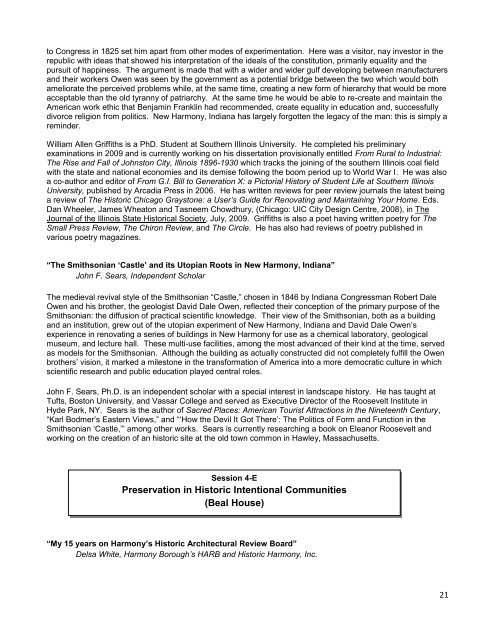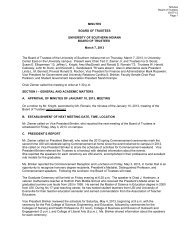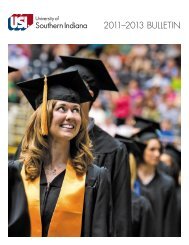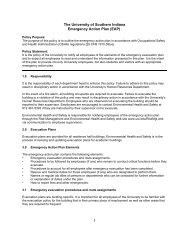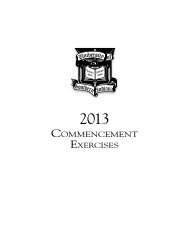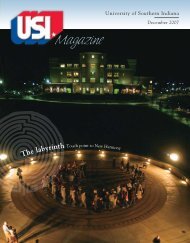Communal Studies Association, 2010 New Harmony, Indiana ...
Communal Studies Association, 2010 New Harmony, Indiana ...
Communal Studies Association, 2010 New Harmony, Indiana ...
You also want an ePaper? Increase the reach of your titles
YUMPU automatically turns print PDFs into web optimized ePapers that Google loves.
to Congress in 1825 set him apart from other modes of experimentation. Here was a visitor, nay investor in therepublic with ideas that showed his interpretation of the ideals of the constitution, primarily equality and thepursuit of happiness. The argument is made that with a wider and wider gulf developing between manufacturersand their workers Owen was seen by the government as a potential bridge between the two which would bothameliorate the perceived problems while, at the same time, creating a new form of hierarchy that would be moreacceptable than the old tyranny of patriarchy. At the same time he would be able to re-create and maintain theAmerican work ethic that Benjamin Franklin had recommended, create equality in education and, successfullydivorce religion from politics. <strong>New</strong> <strong>Harmony</strong>, <strong>Indiana</strong> has largely forgotten the legacy of the man: this is simply areminder.William Allen Griffiths is a PhD. Student at Southern Illinois University. He completed his preliminaryexaminations in 2009 and is currently working on his dissertation provisionally entitled From Rural to Industrial:The Rise and Fall of Johnston City, Illinois 1896-1930 which tracks the joining of the southern Illinois coal fieldwith the state and national economies and its demise following the boom period up to World War I. He was alsoa co-author and editor of From G.I. Bill to Generation X: a Pictorial History of Student Life at Southern IllinoisUniversity, published by Arcadia Press in 2006. He has written reviews for peer review journals the latest beinga review of The Historic Chicago Graystone: a User‟s Guide for Renovating and Maintaining Your Home. Eds.Dan Wheeler, James Wheaton and Tasneem Chowdhury, (Chicago: UIC City Design Centre, 2008), in TheJournal of the Illinois State Historical Society, July, 2009. Griffiths is also a poet having written poetry for TheSmall Press Review, The Chiron Review, and The Circle. He has also had reviews of poetry published invarious poetry magazines.“The Smithsonian „Castle‟ and its Utopian Roots in <strong>New</strong> <strong>Harmony</strong>, <strong>Indiana</strong>”John F. Sears, Independent ScholarThe medieval revival style of the Smithsonian ―Castle,‖ chosen in 1846 by <strong>Indiana</strong> Congressman Robert DaleOwen and his brother, the geologist David Dale Owen, reflected their conception of the primary purpose of theSmithsonian: the diffusion of practical scientific knowledge. Their view of the Smithsonian, both as a buildingand an institution, grew out of the utopian experiment of <strong>New</strong> <strong>Harmony</strong>, <strong>Indiana</strong> and David Dale Owen‘sexperience in renovating a series of buildings in <strong>New</strong> <strong>Harmony</strong> for use as a chemical laboratory, geologicalmuseum, and lecture hall. These multi-use facilities, among the most advanced of their kind at the time, servedas models for the Smithsonian. Although the building as actually constructed did not completely fulfill the Owenbrothers‘ vision, it marked a milestone in the transformation of America into a more democratic culture in whichscientific research and public education played central roles.John F. Sears, Ph.D. is an independent scholar with a special interest in landscape history. He has taught atTufts, Boston University, and Vassar College and served as Executive Director of the Roosevelt Institute inHyde Park, NY. Sears is the author of Sacred Places: American Tourist Attractions in the Nineteenth Century,―Karl Bodmer‘s Eastern Views,‖ and ―‗How the Devil It Got There‘: The Politics of Form and Function in theSmithsonian ‗Castle,‘‖ among other works. Sears is currently researching a book on Eleanor Roosevelt andworking on the creation of an historic site at the old town common in Hawley, Massachusetts.Session 4-EPreservation in Historic Intentional Communities(Beal House)“My 15 years on <strong>Harmony</strong>‟s Historic Architectural Review Board”Delsa White, <strong>Harmony</strong> Borough‟s HARB and Historic <strong>Harmony</strong>, Inc.21


